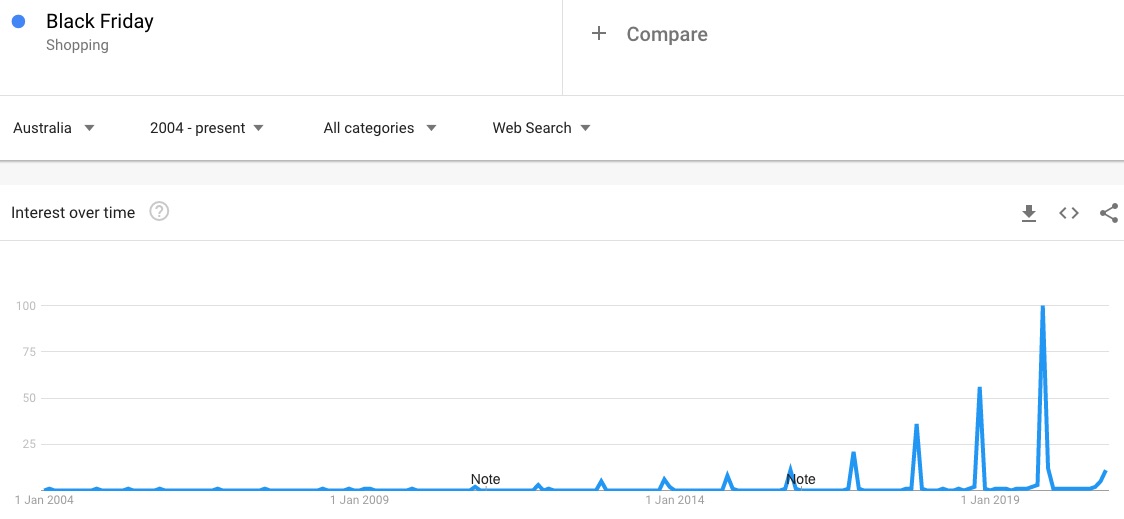30 Seconds Summary:
- Prior to COVID-19, we had already begun to see a seismic shift in the number of people ditching brick-and-mortar stores in favour of online shopping
- COVID-19 continues to change the way businesses are engaging with consumers
- As online shopping reaches an all-time high, the competition for customers is fiercer than ever
- With Black Friday and Cyber Monday right round the corner, it’s time for businesses to prepare their marketing strategies
- Read our eight helpful tips to deliver the best Black Friday marketing campaigns
Thanks to COVID-19, this new home-centric reality has largely impacted the ways in which customers interact with retailers – both in-store and online. This year’s Black Friday and Cyber Monday (BFCM) will be unlike any we’ve ever seen before.
With social distancing capacity limits and increased brick-and-mortar store closures in 2020, many retailers who once relied on in-store foot traffic, are now having to rethink their sales strategy to keep up with consumers shopping online.
This change in consumer behaviour shouldn’t come as a surprise. What used to entail crowded stores, long queues and endless shopping bags, can now be appreciated in the comfort of our own homes. Consumers can now shop anytime, anywhere and have their order delivered within days of making the purchase.
What is Black Friday?
Black Friday continues to evolve from a shopping mall frenzy into an eCommerce bonanza. The term ‘Black Friday’ started gaining traction amongst retailers in the US during the 1980s. The name was a deliberate reference to ‘being in the black’ after a year of poor profits. This mega sale event has quickly become one of the biggest traditions for millions of eager-eyed consumers worldwide.
Over the last decade, Black Friday which falls on the 27th of November, and Cyber Monday on the 30th of November, have taken the Australian retail market by a storm. After all, who doesn’t love a bargain? Well Australians certainly do! According to the 2019 eCommerce Industry report, the Black Friday and Cyber Monday weekend now surpasses Christmas as the peak shopping period.
Since 2004, BFCM sales have set new records each year. In 2019 alone, there were over 673K searches for ‘Black Friday’. What does this kind of data tell us? Put simply, Australian consumers are now spending more time online actively searching for Black Friday promotions, and these consumers are ready to spend. In 2020, we can only assume this number will continue to rise at an exponential rate.
Nine surefire tips to boost your sales this Black Friday
With the current economic climate, supply chain shortages, shipping delays and changes in consumer behaviour, navigating BFCM as a business may feel like an overwhelming task. So if you want to make the most of this year’s mega sales event, it’s time to spring into action.
Despite the uncertainty 2020 has delivered, BFCM is an excellent opportunity for businesses to end the year with a bang!
Make it mobile-friendly
The mobile revolution isn’t on its way; it’s already here. If you want your fair share of the retail season pie, then waste no time in optimising for mobile. In fact last year the eCommerce supergiant – Shopify, recorded more mobile purchases than desktop for the third year in a row. We can only expect this trend to continue as mobile becomes the preferred platform for online shopping and research.
Before the big day, be sure to test and test again. If your mobile site lacks a user-friendly interface or is slow to load, you dramatically increase your chances of losing customers. Slow loading times or device compatibility issues will undoubtedly frustrate online shoppers and send your bounce rate soaring.
Don’t underestimate the power of social media
According to Fiber, 79% of Australians are now using some form of social media daily, with the crowd favourite being Facebook. It’s no secret that to increase sales, you’ve got to be where your customers are. So join in on the conversation, get hash tagging and interact with your audiences!
Start by posting sneak peeks of upcoming sales on your social media channels to pique your customers curiosity. Actively engaging with and answering any customer questions or queries in the comment feed will also aid in building a stronger brand image.
Be sure to include relevant hashtags like #BlackFriday #BlackFriday2020 and #CyberMonday so your target audience can easily find your post. The best part is is you can provide multiple access points for people entering your sale, such as the shopping feature on Instagram where customers can purchase directly from your post.
Send your prospects emails
There’s no denying social media has become a thriving platform for businesses, but email marketing remains a time-tested strategy that has proven to be successful. Promotional messages and campaigns will flood everyone’s inboxes during BFCM. With all of this noise from competing offers, finding ways to stand out is critical.
The email subject line is arguably the most vital component of a successful campaign as it’s the first thing your target audience will see. Crafting an unique, eye-catching and attention-grabbing subject line can be the difference between bagging a new sale or losing a customer to your competitors. Remember you’re competing against hundreds of other brands all trying to achieve the same goal, so don’t be afraid to get creative. This is your time to shine!
Once a prospective customer opens your email, there needs to be something that piques their interest and encourages them to check out your site. The body of the email must be user-friendly, aesthetically appealing and easy to read. Try using bold headlines, shortening big blocks of text and incorporating relevant images.
Last but not least, your email must always include a strong call-to-action (CTA) with a link to your site, to help drive the sale home. This is where you’ll specify what you want your readers to do once they’ve read your email. Try scheduling your emails during peak online engagement and make note of certain time zones for your target audiences.
Segment and personalise
Not two businesses are the same, just as no two customers are the same. If you want to avoid losing prospective customers to your competitors, it’s important to segment each target audience so you can cater to their individual needs and wants. For example, past customers are more likely to engage with your store through promotional discounts or loyalty rewards, whereas potential customers are more likely to be enticed by limited time offers or sign-up deals.
Segmenting and personalisation is where smaller brands can really shine. Segmenting your audiences based on past purchases or consumer behaviour and adding a personal touch to your email marketing can help your brand stand out against the masses.
In the few weeks leading up to BFCM, try testing your subject lines, email content, social posts and marketing messages as teasers for the main event. That way you can monitor your metrics and assess which strategy and campaign is most likely to be successful.
Optimise your BFCM landing pages
Having a dedicated BFCM landing page can help your customers navigate your sale and increase your chances of ranking higher across search engines. The good news is, you don’t have to abandon your holiday-oriented landing pages once the season is over.
By keeping them on your site year-round, you can maintain the SEO benefits and use those pages to help build your mailing list. For example, you may decide to convert these pages into a dedicated sales place where visitors can register for email notifications and stay up-to-date on your latest promotions.
Keep an eye on what your competitors are doing
Keeping an eye on your competition can serve as useful inspiration for your own BFCM campaigns. The quick and simplest way to see what your competitors are doing is to subscribe to their mailing list and analyse the various campaigns they’re testing.
If you decide to offer a 10% discount on a certain product but your top competitor is offering 20% store-wide, you’ve already lost your customers before the sale has even started. It requires you to look at what your competitors are doing and learn how to do it better (without compromising profit margins, of course). But remember, the goal is to stand out, so you want to avoid replicating any competing offerings.
Track your metrics
These rapidly changing consumer habits mean businesses must increase their focus on tracking trends that allows them to respond to new customer segments with targeted messaging and timely offers.
While many customer segments that existed prior to the pandemic will most likely hang round, such as bargain-hunters and luxury seekers, new personas are also beginning to emerge, like online first-timers and instant delivery shoppers. The challenge here is how do businesses meet these ever-increasing consumer expectations?
Understanding consumer behaviour and how your customers navigate your online store is a key component of your marketing strategy. After all, knowledge is power.
Luckily there are tools available, such as Google Analytics, which can help you track, monitor and assess how your shoppers behave.
Turn seasonal shoppers into year-round customers
Do you simply want to increase sales for one weekend? Or would you rather create a long-term strategy that allows you to remain competitive well after the retail season has passed? I think we know the answer.
These mega sales should set the tone for your online presence in the months to come and long after the holiday season ends. Nurturing your relationships with these new customers and keeping them engaged year-round will help you build stronger brand loyalty.
Implement retargeting strategies
Someone leaving your site or abandoning their cart doesn’t necessarily mean your chances of wooing them are done for. After doing the heavy lifting to drive someone to your store, it would be a missed opportunity to not try and re-engage with that potential customer. This is where retargeting comes into play.
There are a number of ways you can entice customers back to your store. Start by retargeting customers through email, Facebook and display advertising. This is also a great opportunity to incorporate product suggestions specifically tailored to their unique interests.
Putting it all together
As the first week of November comes to a close, there’s only a few weeks left to prepare your business for the peak sales of Black Friday and Cyber Monday. Ideally you should already have a plan of attack in place, but for those who are scrambling at the last minute, we’re here to help.
If you wish to reap the benefits of this year’s mega sales event but are struggling with building a strong campaign strategy, simply get in touch today.






